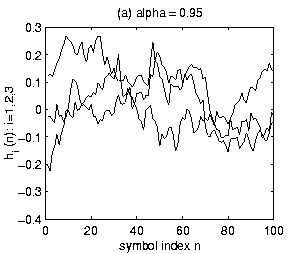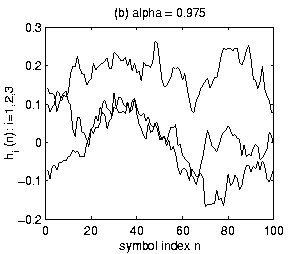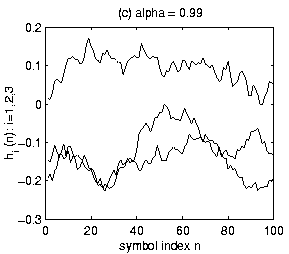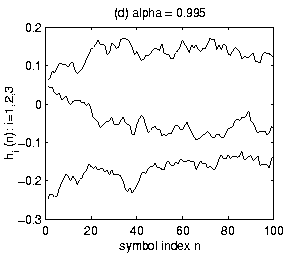Let ![]() represent a complex first-order Markov memory factor such that
represent a complex first-order Markov memory factor such that
![]() where T is the sampling period and
where T is the sampling period and
![]() is the Doppler spread [11].
Let the time-varying channel coefficients follow a Gauss-Markov distribution
such that, at time k,
is the Doppler spread [11].
Let the time-varying channel coefficients follow a Gauss-Markov distribution
such that, at time k,
![]() ,
where
,
where ![]() is complex, white, and Gaussian
with mean
is complex, white, and Gaussian
with mean ![]() and covariance
and covariance
![]() .
In [11] a scalar version of this model is used to represent a
frequency-nonselective fast-fading channel. In [12] a slightly
different first order Gauss-Markov channel model of a frequency-selective
fast-fading channel is used for joint channel/sequence estimation.
.
In [11] a scalar version of this model is used to represent a
frequency-nonselective fast-fading channel. In [12] a slightly
different first order Gauss-Markov channel model of a frequency-selective
fast-fading channel is used for joint channel/sequence estimation.
For this model, the channel covariance matrix sequence is, in steady state,
| (5) |
 |



Figure 1 illustrates several M=3
coefficient Gauss-Markov FIR channels.
For each, the coefficients are zero-mean (i.e.
![]() )
and
uncorrelated across delay with variances
)
and
uncorrelated across delay with variances
![]() .
Over a n=100symbol duration, example trajectories are plotted for the three coefficients.
Figures 1a, 1b, 1c, 1d correspond respectively to
.
Over a n=100symbol duration, example trajectories are plotted for the three coefficients.
Figures 1a, 1b, 1c, 1d correspond respectively to
![]() and
and
![]() .
Reliable MAP
sequence estimation can not be accomplished for a Gauss-Markov channel with
.
Reliable MAP
sequence estimation can not be accomplished for a Gauss-Markov channel with
![]() .
The channel varies too quickly. As expected, as
.
The channel varies too quickly. As expected, as ![]() increases towards one, MAP sequence estimation is more reliable. This will
be illustrated in the simulation section.
increases towards one, MAP sequence estimation is more reliable. This will
be illustrated in the simulation section.